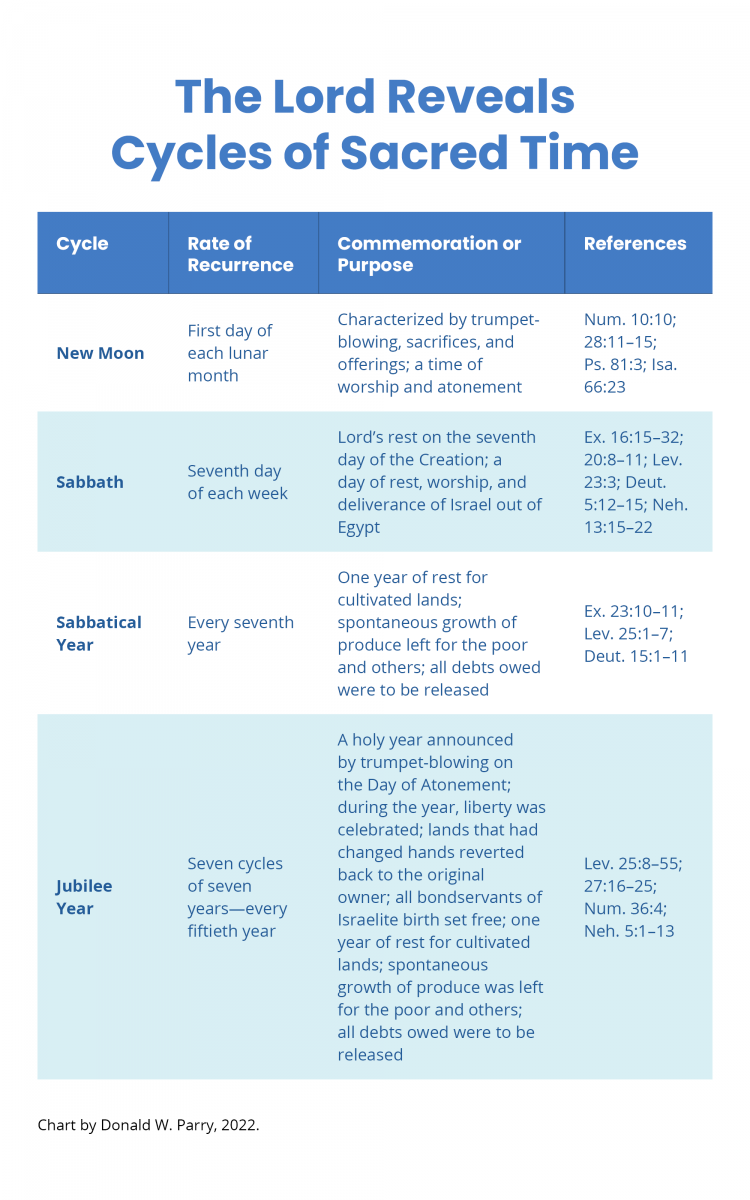You are here
The Lord Reveals Cycles of Sacred Time
| Title | The Lord Reveals Cycles of Sacred Time |
| Publication Type | Book Chapter |
| Year of Publication | 2022 |
| Authors | Parry, Donald W. |
| Book Title | The Jesus Christ Focused Old Testament: Making Sense of a Monumental Book |
| Pagination | 100-101 |
| Publisher | Book of Mormon Central |
| City | Springville, UT |
Show Full Text
God revealed to His covenant people a series of laws that pertained to cycles of sacred time—the New Moon, the Sabbath, the Sabbatical Year, and the Jubilee Year. These cycles existed in addition to annual festivals and fasts, such as Passover and the Day of Atonement.
For each of the cycles, God revealed its rate of recurrence, its purpose, and His expectations for the children of Israel. The cycles had temporal applications in that they permitted the Israelites to rest from their labors, provide for the poor, and free the bondservants.
The cycles also had spiritual applications because they taught Israel about God, the Atonement, and various religious principles. For example, through resting every Sabbath and allowing the land to rest every Sabbatical Year and every Jubilee Year, the Israelites had to demonstrate faith that God would provide for them. Through forgiving debts, the Israelites learned about the principle of forgiveness. And through releasing bondservants, the Israelites perhaps gained knowledge about their own release from sin and spiritual bondage.
Each cycle pertained to the calendar and movements of celestial spheres. The New Moon, characterized by trumpet-blowing and sacrifices, occurred on the first day of the lunar cycle. The other three sacred cycles—the Sabbath, the Sabbatical Year, and the Jubilee Year—occurred according to the sun’s movements. Inasmuch as both the moon and the sun are highly visible celestial spheres that provide light to Earth’s creatures, perhaps the children of Israel recognized God as the power of creation and the source of light.
Further, by witnessing the regularity of the sun and the moon’s movements, the Israelites were able to comprehend God’s order in controlling His creative works.
The number seven is a significant symbol in the cycles of time. The Sabbath, Sabbatical Year, and Jubilee Year featured the number seven—the Sabbath occurred every seventh day, the Sabbatical year occurred every seventh year, and the Jubilee Year occurred after every seven cycles of seven years, or every fiftieth year.[1]
The number seven, which symbolizes completeness and totality and was associated with covenant-making, was tied to the calendar and was marked by established cycles of time.
|
Cycle |
Rate of Recurrence |
Commemoration or Purpose |
References |
|---|---|---|---|
|
New Moon |
First day of each lunar month |
Characterized by trumpet-blowing, sacrifices, and offerings; a time of worship and atonement |
Num. 10:10; 28:11–15; Ps. 81:3; Isa. 66:23 |
|
Sabbath |
Seventh day of each week |
Lord’s rest on the seventh day of the Creation; a day of rest, worship, and deliverance of Israel out of Egypt |
Ex. 16:15–32; 20:8–11; Lev. 23:3; Deut. 5:12–15; Neh. 13:15–22 |
|
Sabbatical Year |
Every seventh year |
One year of rest for cultivated lands; spontaneous growth of produce left for the poor and others; all debts owed were to be released |
Ex. 23:10–11; Lev. 25:1–7; Deut. 15:1–11 |
|
Jubilee Year |
Seven cycles of seven years—every fiftieth year |
A holy year announced by trumpet-blowing on the Day of Atonement; during the year, liberty was celebrated; lands that had changed hands reverted back to the original owner; all bondservants of Israelite birth set free; one year of rest for cultivated lands; spontaneous growth of produce was left for the poor and others; all debts owed were to be released |
Lev. 25:8–55; 27:16–25; Num. 36:4; Neh. 5:1–13 |
Terms of Use
Items in the BMC Archive are made publicly available for non-commercial, private use. Inclusion within the BMC Archive does not imply endorsement. Items do not represent the official views of The Church of Jesus Christ of Latter-day Saints or of Book of Mormon Central.
Bibliographic Citation
Subscribe
Get the latest updates on Book of Mormon topics and research for free

